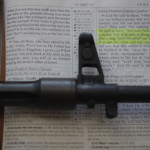We run our website the way we wished the whole internet worked: we provide high quality original content with no ads. We are funded solely by your direct support. Please consider supporting this project.

Part 4: An Alternative Cross-Centered Approach
Image by Karl Pang via Flickr
As I mentioned in Part II of this review, I am deeply appreciative of the fact that Flood grasps the centrality of enemy-loving non-violence in Jesus’ revelation of God. And while many, if not most, of the depictions of Yahweh in the Old Testament are consistent with this revelation, I fully agree with Flood that the Old Testament’s violent depictions of God are not. The most fundamental way that Flood and I part ways is that I am convinced that the same Jesus who reveals God’s enemy-loving and non-violent nature also endorses the entire Old Testament as an authority that was “breathed” by God. And, according to Jesus, it was “breathed” for the ultimate purpose of bearing witness to him. I thus take it on Jesus’ authority that this holds true even for passages of Scripture that strike us as morally repugnant.
I agree with Flood that, in light of what Jesus reveals about God, we should never blindly submit to any morally repugnant interpretation of a biblical passage. But rather than rejecting the apparently repugnant passage as uninspired, I believe allegiance to Jesus requires us to affirm that this passage is divinely inspired and that it somehow bears witness to Christ. Our task as Christ-centered Bible interpreters is to determine how this is so.
It is admittedly not obvious how morally repugnant portraits of God such as those that depict Yahweh commanding the merciless slaughter of women and children could possibly bear witness to Christ. But the challenge becomes more daunting still when we understand that everything Jesus was about was oriented around his self-sacrificial death on the cross.[1] When Jesus explained to his disciples “what was said in all the Scriptures concerning himself,” it centered how the Messiah had “to suffer” before entering “his glory” (Lk 24:26-7; cf., vss.44-6). So central is the cross for understanding everything that Jesus was about that Paul could use “Gospel” and “message of the cross” interchangeably (1 Cor 1:17-8, 23). Hence, to be an enemy of the Gospel of Christ is to simply be an enemy “of the cross” (Phil 3:18). Paul could even go so far as to claim that he “resolved to know nothing” among the Corinthians “except Jesus Christ, and him crucified” (1 Cor 2:2). While Paul was undoubtedly somewhat hyperbolic in claiming this, his statement suggests that everything concerning his understanding of God and the Gospel was contained in the crucified Christ. And this is confirmed in the fact that the cross completely overturned Paul’s conception of God’s power and wisdom (1 Cor 1:18, 24).
Along the same lines, it was on the cross, according to John’s Gospel, that God was most clearly “glorified” (Jn 12: 27-8, 31-3; cf., 13:31-2). And this was because it was on the cross that God fully revealed the perfection of his love by going to the furthest extreme possible on our behalf. Out of love, the all-holy God in some sense became our sin (2 Cor 5:20), and the triune God who is perfectly united in love became our God-forsaken curse (Gal 3:13; cf., Mt 27:46). Hence, John captures the essence of Jesus’ revelation of God by declaring that “God is love” (1 Jn 4:8) while defining “love” by pointing us to the cross (1 Jn 3:16).
In this light, whereas Flood calls on us to read the Bible morally, using our conscience and life experience as our guide (89), I submit we should read the Bible crucicentrally – viz. through the lens of the cross. Our most important hermeneutical task is to discern how portraits like the one of Yahweh commanding genocide bear witness to the non-violent, self-sacrificial, enemy-loving character of God that is most perfectly revealed on the cross! While this may seem to be an impossible feat, I’ve become convinced that the cross holds the key to discerning how these portraits bear witness to Christ.
When I first confronted this task nine years ago, I found the advice of Origen to be extremely helpful.[2] Origen was very forthright about the biblical and theological conundrums he wrestled with, including the problem posed by the Old Testament’s violent portraits of God. When we come upon morally offensive material in Scripture, Origen encourages us to never get stuck in our anger, disgust, or frustration or to suspect that this material is “unworthy of God.” Rather, holding the unresolved conundrum in mind while remaining confident that all Scripture is “God-breathed,” Origen teaches that we should humbly submit ourselves to God and patiently wait for the Spirit’s illumination. In time, Origen assures us, the Spirit will enable us to see beyond the surface appearance of things, where the conundrum resides, and find a resolution in a deeper, more profound, revelatory truth. The Spirit, he holds, can open our eyes to see God’s beauty in the depth of Scripture’s morally repugnant material.
Nine years ago, I arrived at the same conclusion as Flood regarding the inadequacy and danger of the Evangelical attempts at minimizing and/or justifying the violence attributed to God in Scripture. And it was at this point that I first began to apply Origen’s advice to this problem. For several months I contemplated a long list of passages I had compiled that depict God violently while simultaneously reassuring myself that God’s true character was fully revealed on the cross. It is of course not for me to say whether or not what eventually happened to me as a result of this contemplative exercise was an illumination of the Holy Spirit, but I can only describe it as similar to what happens when a person stares “the right way” at the two-dimensional patterns of a “Magic Eye” picture and suddenly sees a three-dimensional object rise out of it. Prayerfully contemplating Scripture’s violent portraits of God with the conviction that they must somehow point to the God revealed on Calvary, I suddenly began to catch glimpses of the crucified God in these violent portraits!
I have since come to believe that the cross is the “Magic Eye” that unveils several ways in which the Old Testament’s violent divine portraits bear witness to various aspect of the revelation of God on the cross. For the present, it must suffice to mention one core aspect of this cross-centered, “Magic Eye” perspective.
This perspective began to dawn on me when I asked myself the question: How does the cross function as the definitive revelation of God? Looking at it with the natural eye (in a first century Jewish context), there is nothing to suggest that this guilty-appearing, God-forsaken, crucified criminal is the definitive revelation of God. This crucified criminal can only be understood to be the definitive revelation of God when we by faith discern what else is going on behind this appearance. And what faith sees going on behind this horrific appearance is a God of unfathomable love stooping an infinite distance to become our sin and our curse and to thereby take on a hideous appearance that mirrors our sin and our curse. We must by faith look past the ugly, sin-mirroring surface to behold the beauty of the divine revelation, for the revelation is not located on the surface appearance, but in God’s loving condescension to assume this appearance.
Since the God who “breathed” his definitive revelation on the cross is the same God who “breathed” all Scripture for the purpose of bearing witness to the cross, I began to wonder where else God might have “breathed” a revelation of himself by stooping to bear the sin of his people and to thereby take on an appearance that mirrors this sin? Where else might we need to exercise faith to look past an ugly sin-mirroring surface appearance to behold the humble beauty of God stooping to assume this appearance? And as I wondered this, it struck me that this is the only way Scripture’s violent divine portraits can be understood to bear witness to the crucified Christ.
If we interpreted them through the lens of the cross, each violent portrait of God can be understood as a literary harbinger of the cross. The presence of these sin-bearing portraits within the “God-breathed” written witness to God’s covenantal faithfulness serve to remind us that God has always been willing to humbly stoop as far as necessary to remain in relationship with his fallen people. The ugliness of the sin-mirroring surface appearance of the cross is reflected in the ugliness of the sin-mirroring surface appearance of these violent portraits. And if as we encounter these portraits we exercise the same faith we exercise to discern the definitive revelation of God on the cross, we can discern behind the surface appearance of these violent portraits the same cruciform God stooping out of love to bear the sin of his people.
Yet, we will only discern the revelatory content of these violent divine portraits if we follow Origen’s advice and hold fast to two apparently incompatible convictions. We must hold fast both to the conviction that the crucified Christ is the full revelation of what God is truly like and to the conviction that all Scripture, including its violent divine portraits that conflict with the revelation of God in the crucified Christ, are “God-breathed” for the purpose of bearing witness to the crucified Christ. Conservative interpreters who locate the revelatory content of Scripture’s violent portraits of God on their surface appearance fail to hold fast the first and compromise the beauty of the revelation of the cross. But more progressive Christians like Flood who don’t look for any “God-breathed” revelatory content in these portraits fail to hold fast to the second and thereby compromise the divine authority of Scripture.
In my opinion, both groups miss the opportunity to acquire the “magic eye” that allows us to discern how even the most violent of Scripture’s divine portraits reveal the non-violent, self-sacrificial, enemy-loving character of God revealed on Calvary.
[1] I am here giving a small sampling of the New Testament material illustrating the centrality of the cross. For more in depth discussions, see R. Bauckham, God Crucified: Monotheism and Christology in the New Testament (Grand Rapids: Eerdmans, 1998); idem., “Cross, Theology of the,” in New Dictionary of Theology, ed. S. B. Ferguson, D. F. Wright (Leicester: IVP, 1988), 181-3;M. Gorman, Cruciformity: Paul’s Narrative Spirituality of the Cross (Grand Rapids: Eerdmans, 2001); idem., Inhabiting the Cruciform God: Kenosis, Justification, and Theosis in Paul’s Narrative Sorteriology (Grand Rapids: Eerdmans, 2009); idem., Apostle of the Crucified Lord: A Theological Introduction to Paul and His Letters (Grand Rapids: Eerdmans, 2004); U. Luz, “Theologia Crucis als Mitte der Theologie im Neuen Testament,” EvTh, 34 (1974), 116-41; C. Cousar, A Theology of the Cross: The Death of Jesus in the Pauline Letters (Minneapolis: Fortress, 1990); T. Caroll, J. B. Green, “’Nothing but Christ and Him Crucified’: Paul’s Theology of the Cross,” in The Death of Jesus in Early Christianity (Peabody, Mass: Hendrickson, 1995), 113-32.
[2] For the following, see Origen, On First Principles, trans. G. W. Butterworth (Gloucester, MA: Smith, 1973), II.2.2;5; IV. 1.7; 2.7-9, 3.10, 11. 14-5.
Category: General
Tags: Bible, Book Reviews, Cruciform Theology, Derek Flood, Disarming Scripture, Jesus, Magic Eye, OT Violence
Topics: Interpreting Violent Pictures and Troubling Behaviors
Related Reading

Did Jesus Instruct Us to Arm Ourselves?
Over the past few posts, I’ve been dealing with the passages that are frequently used to argue how Jesus condoned violence. One of these takes place just after the last supper and just before Jesus and his disciples were going to travel to the Mount of Olives to pray. To prepare his disciples, Jesus tells them;…

The H.R. Hutzel Interview (podcast)
Greg interviews Heather Hutzel about her book Anointed and talks about writing, fiction, the narrative nature of scripture, and much, much more. You can get a copy of her book HERE. H.R. Hutzel (Heather Rae) never aspired to be a writer or dreamed of writing a book. But that all changed when she prayed a…

When the Law Demanded the Death Penalty
The Sinai covenant is significantly structured around violence. It motivates behavioral conformity by promising rewards and threatening violence. Without the threat of violence, the law looses its “teeth.” If the law is an acquiescence to sin, then the divinely sanctioned violence that is associated with it must also be considered an acquiescence to sin. The…

To What Extent is the Old Testament a Sufficient Revelation of God? (podcast)
Greg considers the relationship between the testaments. Episode 548 http://traffic.libsyn.com/askgregboyd/Episode_0548.mp3

The Danger of the Penal Substitution View of Atonement
About 25 years ago I was traveling on the freeway to somewhere or other and I stopped at a truck stop to get a bite to eat. I sat down at the counter next to this scruffy truck driver who had just started his lunch, and we started up a friendly conversation. Within about fifteen…

Jesus, the Center of Scripture
Paul declared that Jesus was nothing less than the very embodiment of all of God. This distinction of “all of God” is important for us to understand what it means for us to see Jesus and God rightly. Battling proto-gnostic teachers who were apparently presenting Christ alongside other manifestations of God, Paul declares “in Christ…
